On Preservation: Well-heeled hero wanted to free Wright’s tarnished treasure
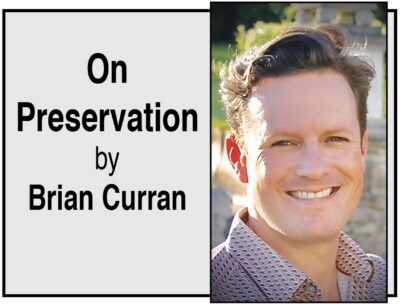 When Harriett Freeman deeded her home in the Hollywood Hills to the University of Southern California in 1984, she must have thought that she had taken an action to ensure its preservation and protection. Built in 1924, the rare architectural treasure was designed for Samuel and Harriett Freeman by none other than America’s most renowned architect, Frank Lloyd Wright. For USC, it was the opportunity to add to the university’s collection of architectural icons that included Greene and Greene’s craftsman masterpiece Gamble House in Pasadena.
When Harriett Freeman deeded her home in the Hollywood Hills to the University of Southern California in 1984, she must have thought that she had taken an action to ensure its preservation and protection. Built in 1924, the rare architectural treasure was designed for Samuel and Harriett Freeman by none other than America’s most renowned architect, Frank Lloyd Wright. For USC, it was the opportunity to add to the university’s collection of architectural icons that included Greene and Greene’s craftsman masterpiece Gamble House in Pasadena.
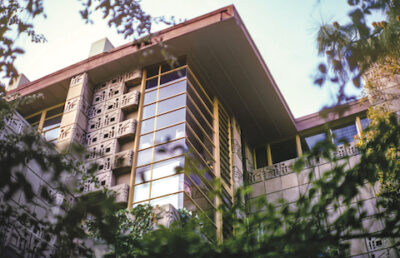
FREEMAN HOUSE on Glencoe Way, overlooking Hollywood and Highland.
Barely 40 years after the Freeman House passed into USC’s hands intact, the building is now forlorn, plundered and decrepit, and it is on the market looking for a “conservation minded buyer,” according to the online real estate site The Real Deal, “who can properly rehabilitate and maintain” the historic home. Harriett must be spinning in her grave.
The Freeman House is one of four “textile block” houses that Wright designed and built in Los Angeles between 1922-1934, the others being the Storer House in Hollywood, the Ennis House in Los Feliz and the Millard House in Pasadena. In his attempt to find a simple and cost-effective method for ordinary people to build their own homes, Wright conceived the “textile block” system of modular construction using pre-cast concrete blocks made from sand taken from the site itself, and tied together with steel rebar. He even embellished the blocks with swirling Art Deco designs which provided ornamentation on the façade and in the interior. In conjunction with Wright’s architectural massing, square columns and dramatic spatial arrangements, the result was miniature “Mayan Revival” temples rising out of the landscape.
1994 earthquake
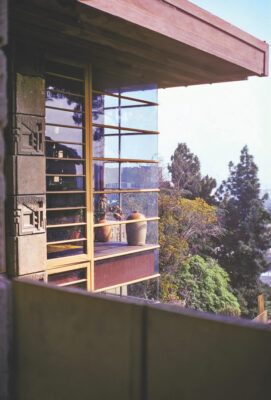
TRANSPARENT diagonal corners are a prominent Freeman House feature.
USC’s stewardship of the Freeman House started out well, but tragedy struck with the 1994 Northridge Earthquake that severely damaged the house. USC School of Architecture Dean Robert Timme threw himself into the stabilization and restoration effort spearheading a campaign that secured nearly $2.5 million from FEMA, as well as grants and donations from individuals and charitable organizations such as the Getty Foundation. Work began in 2000 and stabilization was complete by 2005. With the death of Timme that same year, work slowed, and USC’s interest in the house waned, which led to “LACurbed” in 2008 to ask “Freeman House Restoration: What the Hell Is Taking So Long?”
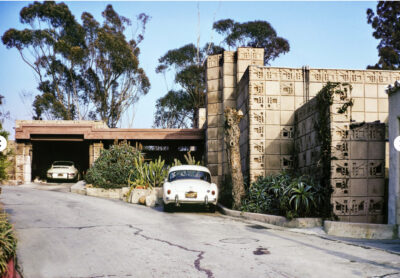
GLENCOE WAY in Hollywood is the front of The Freeman House.
Despite minor restoration work and utilization as a residence for USC architecture students and the completion of exhaustive studies, the Freeman House continued to deteriorate through the 2010s. Faced with increasing criticism over the neglect of the house, lack of leadership, declining funds and mounting costs, USC listed the house briefly in 2016 for an undisclosed amount, only to take it off market soon after. USC’s disastrous management of the house was further highlighted in 2019 when the “Los Angeles Times” reported that three pieces of custom furniture designed by Wright for the house — potentially worth hundreds of thousands of dollars — were stolen from a South Los Angeles warehouse, with the theft going unreported for six years. One of the textile blocks from the house also ended up on Ebay and later sold at auction for $5,000.
So now, after years of mismanagement and neglect, USC is finally throwing in the towel. Battered by recent scandals and the pandemic and massive financial losses totaling $1 billion, the university is being forced to shed assets. It has already unloaded the USC president’s mansion, the Seeley Mudd Estate, and is now listing the Freeman House for $4.25 million.
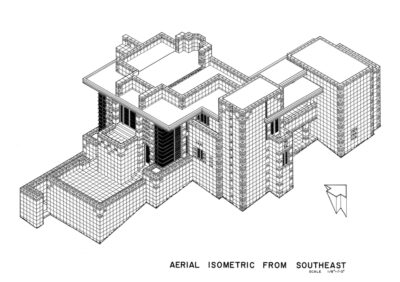
ISOMETRIC DRAWING of the Freeman House, drawn by Jeffrey B. Lentz in 1969.
Any private buyer of the house will be taking on a Herculean restoration effort, to the tune of millions. It took billionaire Ron Burkle buying the largest of Wright’s textile block houses, the Ennis House, for $4.5 million in 2011 to ultimately preserve that masterpiece. Burkle sold the house in 2019 for $18 million after having spent $17 million on its restoration.
Whoever the knight in shining armor is, perhaps his or her most heroic act will be rescuing the Freeman House from the institutional decline of USC. Then, perhaps, the ghost of Harriett Freeman finally can be at peace.
Inquiries: Deasy Penner Podley: tinyurl.com/emec4swu
Category: Real Estate
